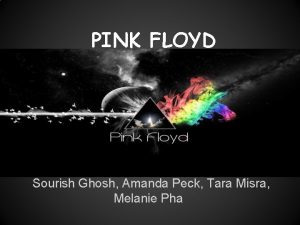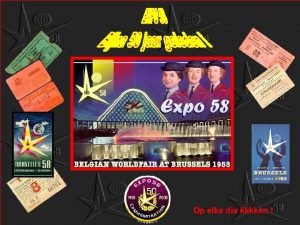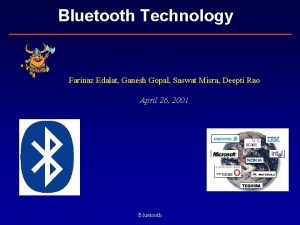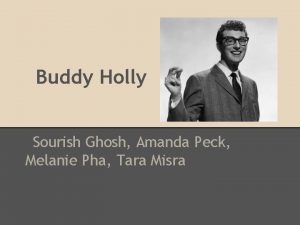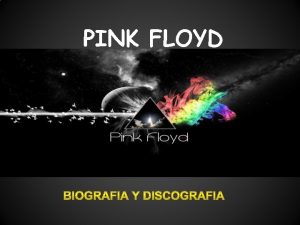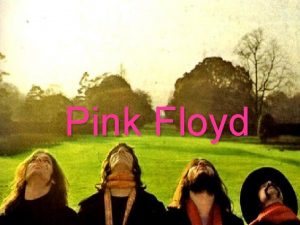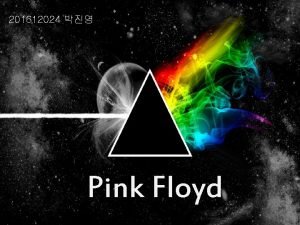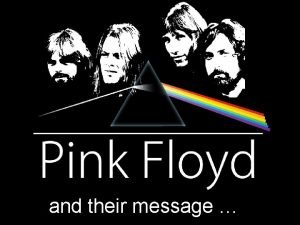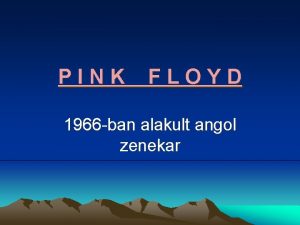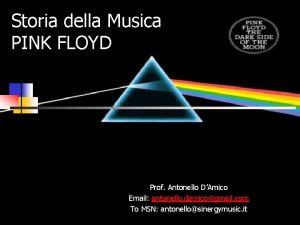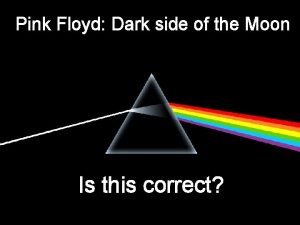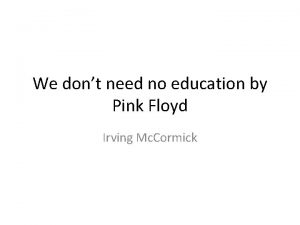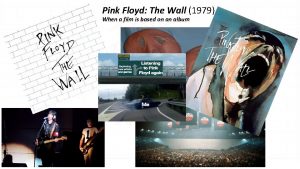PINK FLOYD Sourish Ghosh Amanda Peck Tara Misra
































- Slides: 32

PINK FLOYD Sourish Ghosh, Amanda Peck, Tara Misra, Melanie Pha

INTRODUCTION Pink Floyd, has achieved international acclaim with their progressive and psychedelic music. The group has been one of the most innovative groups both in concert and studio. Their music has almost taken on a classical, operatic quality, and has pushed boundaries of music to their outer limits. Moreover they are one of the most commercially successful and musically influential groups in the history of popular music.

HISTORY In 1964, Roger Waters, Richard Wright and Nick Mason formed Sigma 6. They changed their band names, and in Autumn 1966 they recruited two guitar players Bob Close and Roger Syd Barret. They eventually changed their name to The Pink Floyd Sound. Before long, they dropped the words "The" and Sound" and made their first album The Piper at the Gates of Dawn. They recorded this right down the hall from where The Beatles were recording Sgt Peppers. So they got to know The Beatles very well.

HISTORY CONTINUED In late 1967, David Gilmour was added as the fifth member of Pink Floyd. He was supposed to cover for Syd Barrett on stage. However Syd's acid addiction got the better of him, and Syd was institutionalized for drug abuse in 1974. The band continued on without Syd.

PINK FLOYD MUSIC BIOGRAPHY The group landed a recording contract with EMI and made the Top 20 with a brilliant debut single "Arnold Layne" Their 1973 album Dark Side of the Moon finally broke Pink Floyd as superstars in the United States where it reached number 1. The follow-up Wish You Were Here also became number 1.

MUSICAL STYLE HISTORY At first, Pink Floyd were much more conventional, concentrating on the rock and R&B. However they quickly began to experiment, stretching out songs with wild instrumental freak-out passages incorporating feedback, electronic screeches, and unusual eerie sounds created by loud amplification, reverb and such tricks as sliding ball bearings up and down guitar strings.

Other Musical Styles of the Time (60 s) -Psychedelic Rock, Blues Rock, Folk Rock were among the popular musical styles of the 1960's -Later half included Progressive Rock and Heavy Rock -Popular groups include: The Beatles, Rolling Stones, The Animals, The Yardbirds, Led Zeppelin, The Beach Boys

Musical Elements of 1960's -Rhythm and Blues continued to influence the style of Rock Music -Improvisation became more popular -Experimentation with classical music styles such as Baroque -Rock music had many different genres/styles at this point

Other Musical Styles of the Time (70 s) -Popular styles of rock included: Progressive Rock, Hard Rock, Country Rock, Punk Rock, and Blues Rock -Popular groups included: Led Zeppelin, AC/DC, Aerosmith, Journey, Bob Dylan, Queen, Eric Clapton, Fleetwood Mac

Musical Elements of the 1970's -Many different groups of music now. R&B, country, pop, and rock seem to be separate categories of music -Experimental music included electronic music with synthesizers or harmonicas -Rock music became a fusion of different sounds (ie: southern rock combined rock, country, and blues music)

The Genre of Pink Floyd Music Progressive Rock What is Progressive Rock? -The combining of rock rhythm with elements of art music: instrumentation, extended song form, harmony sophistication, lyrical complexity, metric complexity, complex rhythms, and/or virtuosity. -For a group to be called "progressive rock" their music did not need to possess all of these elements. Only some measure of incorporation of art music style into their rock music was needed for the label

Progressive Rock continued. . . -Experimentation and innovation of rock music into something more sophisticated than previous rock music were the goals of progressive rock groups. -The result was an expansion of what was considered "rock" music, changes in how the audience appreciated rock music, and the development of further musical styles. -Instead of thinking of progressive rock music as an attempt at classical music, consider it as "popular avantgarde" -With so many variables to use, the

Did Pink Floyd live up to the Progressive Rock genre? YES! -Pink Floyd experimented with sounds, production, song form, length of songs, lyric content and complexity, instrumentation, musical style, and continued to change and develop their style throughout their career. -The band did not generally have the art music elements of virtuosity, or metric complexity (other than Money)

Musical Style of Pink Floyd: General The normal instrumentation of the band: keyboard (Wright), bassist (Waters), drummer (Mason), lead guitar (Barrett until 1968, then Gilmour), guitar (Gilmour pre 1968), and vocals (Barret on lead pre 1968, and after Gilmour and Waters were co-lead vocalists) Musical Style: creating a "quasi-instrumental fantasy"

The Elements of the Music -They experimented with unique instrumentation (examples: a Russian wolfhound as lead vocalist, organ, full orchestra, Zinovieff's VCS 3 synth, the use of noises from everyday life) -They used free form improvisation on all instruments, or just during solos/extended instrumental periods in their songs -Loud noise freak-outs where there was a mixture of sounds at once that often conflicted (Early period)

Elements of the music continued. . . -Languid, hypnotic and mellow song style (Later period) -Cosmic/space rock sound in the music and content in the lyrics -They experimented with electronic sound effects -Pink Floyd usually used a 3/4 or 4/4 time signature (or switching between those two meters) in their songs with few unique meter changes (other than Money)

Elements of the music continued. . . -Sonic experimentation both in the manipulation of their instruments but also in production (examples: manipulated amplified sound, used extensive producing techniques to make the sound seem like it was moving, or in concert used a machine to create a swirling sound

Style Changes throughout their Career Syd Barrett as leader: -Barrett wrote songs that were influenced by psychedelic rock, surf music, humor, literature, and British whimsy -First two albums, with Barretts involvement and writing almost all of the first album, are classified as psychedelic rock or cosmic rock due to the spacey sounds and themes

Syd Barrett as leader continued. . . -Although termed "psychedelic rock" the songs in the albums ranged in style from avantgarde, to whimsical, to space themed. -The sounds were sometimes a cacophony of noise that was barely held together (musical freak outs)

Post-Barrett - Dark Side of the Moon General song form (now the form was a little more standard than in Barrett's day): Introduction is unusual, instrumental and mystical/meditative. This is followed by the principal melody, or "song proper". After the "song proper" there is a long instrumental section that hits the climax and is brought down in the end with a reestablishment of the "song proper" in repetition, some theme of it, or variation on theme

Post Barrett-Dark Side of the Moon -The lyrics were now mostly written by Waters. Pink Floyd "should be considered [a progressive rock group] on the basis of its lyrics". The lyrics of Waters borrow themes found in modern art: early twentieth century British romanticism, existentialism, and social/cultural pessimism - Deena Weinstein (Rock historian and Sociologist) -unusual electronic timbres were still used as well as an unexpected combination of sounds

Dark Side of the Moon - break up -Waters's lyrics became even more pessimistic -Listening to the music did not take as much commitment or focus -The form became more standard -The unexpected combination of sounds were less abrasive and less challenging to the ear -There was still experimentation but only a few songs fit Pink Floyd's earlier level of experimentation

Dark Side of the Moon- break up -The band hired a producer, Bob Ezrin, to guide them in making their music more palatable for the masses -A similar trend of other progressive rock groups going more mainstream was followed, although Pink Floyd did not conform to the extent of other groups -Some argue, that in the end, Pink Floyd went from innovating psychedelic rock to transforming it into easy listening muzak for

Pink Floyd Live Performance -Lavish stage shows -Artists were almost secondary to the visual experience -Pink Floyd was one of the first bands with a set traveling light show with their tour. -They used psychedelic patterns on a large screen (Mr. Screen), and used film clips and slides. -Later the shows expanded and included pyrotechnics, lasers, additional special effects, large balloons, and building a wall (the Wall)

MUSICAL ANALYSIS Comfortably Numb Beats: Duple Subdivision Tempo: Moderate Predominant Musical Texture: Homophonic Melody and Accompaniment Special Focus: David Gilmour's Guitar Solo in the song was rated the 4 th best guitar solo by Guitar World magazine

Comfortably Numb continued. . . Meter: 4/4 (Straight time) Instrumentation: drums, bass, electric guitar, orchestra (at least a strings section), electronic sound effects, wind chimes Form: Strophic: AAABC verse chorus solo verse chorus solo

Comfortably Numb in the context of Pink Floyd music -This song is clearly from Pink Floyd's later period. There are no musical freak out moments or sounds that clash. The entire song is smooth, dreamlike and flowing which rides over a hard hitting rock rhythmic structure. -The song, although it has some experimentation with the instrumentation and electronic sound, is closer to mainstream rock than some of Pink Floyd's early work -The lyrics are darker and fit into Water's more pessimistic period.

Influences of Pink Floyd -Pink Floyd was influenced by popular groups such as: Jimi Hendrix, Byrds, Grateful Dead -Influenced by Rhythm and Blues genre -Influence in the band came from Syd, who was the primary songwriter, lead guitarist, and lead singer

Pink Floyd's Influence on Other Artists -Pink Floyd influenced artists such as: David Bowie, Genesis, Queen, Phish, Radiohead, Smashing Pumpkins, Nine Inch Nails, and Yes -Pink Floyd's experimentation and musicianship influenced both artists and the music industry

The Legacy of Pink Floyd -Pink Floyd is widely recognized as one of the greatest rock bands in history. They pushed the boundaries of rock music in the progressive rock period of the late 1960 s until the mid 1970 s, inspiring bands and opening the way for further electronic experimentation. -Like other progressive rock groups at the time, at the end of the 1970 s Pink Floyd developed their musical style into one with less experimentation and more mainstream rock rhythm. They did not completely sacrifice their musical experimentation as their electronic and instrumental experimentation continued. -The Wall Live concert tour is current and worldwide. Even with only Roger Waters in it, the music of Pink Floyd and show they created are still relevant and sought after today.

References 1) Pink Floyd Music (2013) Retrieved from http: //www. pink floyd music. com/history 1. html 2) Pink Floyd Biography Retrieved from http: //www. allmusic. com/artist/pink floyd mn 0000346336 3) Comfortably Numb (2005) Retrieved from http: //en. wikipedia. org/wiki/Comfortably_Numb 4) Biography of Pink Floyd bio, band history, career, evolution, music, Roger Waters, David Gilmour. (n. d. ). Pink Floyd - Lyrics, songs, Biography, Discography, Interviews, Picture Gallery. Retrieved June 11, 2013, from http: //pinkfloydweb. yaia. com/biography. html 5) Johnson, J. (2004). twentieth century music, 1, pp 297 301 doi: 10. 1017/S 1478572205230177 6) Hudson, K. (2002). Progressive rock reconsidered. New York: Routledge. 7) Macan, E. , & Reisch, G. A. (2007). Psychedelics of Alienation. Pink Floyd and philosophy: careful with that axiom, Eugene! (pp. 106 119). Chicago: Open Court.

8) Scaruffi, Piero (1999). The History of Rock Music. Pink Floyd: biography, discography, reviews, links. Piero Scaruffi's knowledge base. Retrieved June 11, 2013, from http: //www. scaruffi. com/vol 2/pinkfloy. html 9) Marsh, Dave (1989) "The Heart of Rock and Soul, The 1001 Greatest Singles Ever Made". Popular music of the 1960's. Lex Jansen website. Retrieved June 11, 2013, from http: //www. lexjansen. com/cgi bin/marsh_xml. php? fn=87 10)Progressive Rock Music. Popular progressive rock musicans. All music website. Retrieved June 11, 2013 from http: //www. allmusic. com/style/prog rock ma 0000002798 11)History of Rock in 1960 s. Popular artists and genres of the 1960 s. The people history. com. Retrieved June 11, 2013 from http: //www. thepeoplehistory. com/60 smusic. html 12) Rock n' Roll Timeline 1970 1979. History of rock music in the 1970 s. digitaldreamdoor. com Retrieved June 11, 2013 from http: //www. digitaldreamdoor. com/pages/best_timeline r 3. html
 Scaruffi pink floyd
Scaruffi pink floyd Belgische powerpoint presentatie pink floyd
Belgische powerpoint presentatie pink floyd Consumerism songs
Consumerism songs Kashiprasad ghosh
Kashiprasad ghosh Advocate prodipto ghosh
Advocate prodipto ghosh Programming in c by pradip dey
Programming in c by pradip dey Joydeep ghosh
Joydeep ghosh Shibani ghosh
Shibani ghosh Responsibility for climate change
Responsibility for climate change Urmi ghosh-dastidar
Urmi ghosh-dastidar Programming in c by pradip dey
Programming in c by pradip dey Dr ranjan ghosh
Dr ranjan ghosh Dibyajyoti ghosh
Dibyajyoti ghosh Dr ranjan ghosh
Dr ranjan ghosh Manzum nedir
Manzum nedir Saswat misra
Saswat misra Misra-gries
Misra-gries Bactig
Bactig Sumit misra
Sumit misra Dipti misra sharma
Dipti misra sharma Gregory peck homo
Gregory peck homo Robert peck developmental tasks
Robert peck developmental tasks Badayos pagsulat
Badayos pagsulat Sister knight
Sister knight Dr andrew peck
Dr andrew peck Klasifikasi pondasi
Klasifikasi pondasi Robert peck developmental tasks
Robert peck developmental tasks Jackie peck
Jackie peck Peck's theory of ego integrity
Peck's theory of ego integrity Dr andrew peck
Dr andrew peck Peck's expansion of erikson's theory
Peck's expansion of erikson's theory Essential requirements of a contract
Essential requirements of a contract Alice peck hamden
Alice peck hamden
